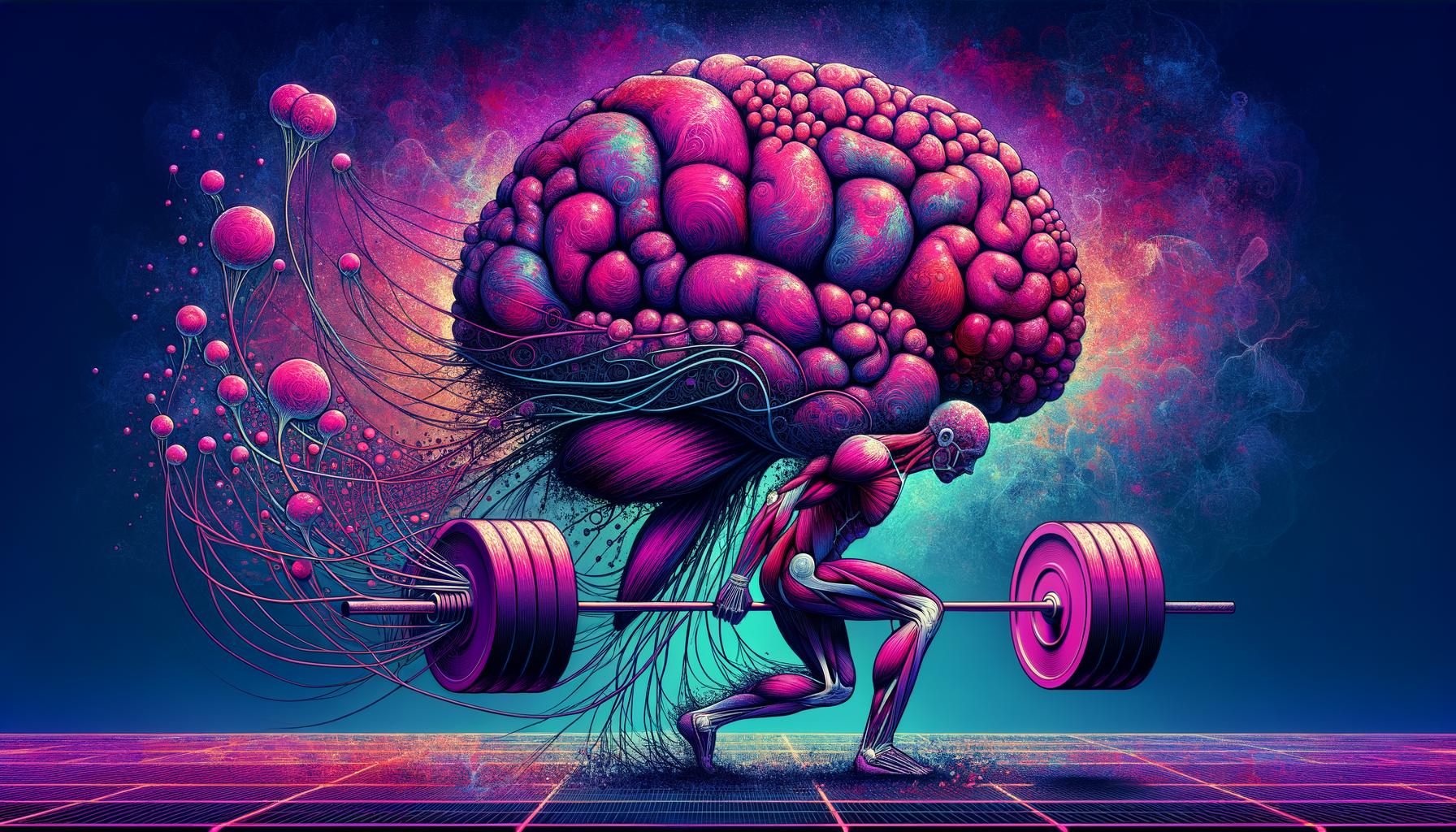· fitness · 15 min read
Understanding CNS Fatigue: Navigating Through High-Intensity Training
Dive into the world of CNS fatigue during high-intensity exercise. Learn the distinguishing factors between muscle and CNS fatigue, and uncover their impact on athletic performance.

In This Post
The Fact Why Should I Care How To Put In Action Start Tomorrow Guide How does it effect my ability to focus How does it impact my daily life How does it help me make friends How does it help me manage stress How does it effect my mood Summary: Remember Refresher Checklist The Full Research Article CitationsPrint Out The Tomorrow Checklist!
Sign up for our newsletter and receive a copy today, so that, you can start tomorrow! Or the next day, or the day after that. I forget everything and starting things is hard at least for me so these checklists are godsend.
Print Out The Remember Refresher Checklist!
Sign up for our newsletter and download your own copy of the Remember Refresher Checklist, so that, you can easily put it on your fridge and help you stay on target towards your WHY. Every little bit helps.
Introduction to CNS and Muscle Fatigue
The sweat, the strain, the unwavering determination - every athlete knows these all too well. Underneath the visible effort lies an unseen player: the Central Nervous System (CNS). It’s the control center, orchestrating every move, every breath, and every heartbeat. But what happens when this critical system starts to falter? When the CNS fatigues, the ripple effects can significantly impact athletic performance. This section dives deep into the basics of the CNS, its pivotal role in exercise, and the phenomenon of muscle fatigue, setting the stage for understanding the less-talked-about CNS fatigue.
Overview of CNS in Exercise
The CNS, comprising the brain and spinal cord, is the maestro of muscle recruitment and overall body movements. In every high-intensity training session, when you’re pushing your limits, it’s the CNS that sends out the signals for muscle contraction, ensuring that your body responds correctly to the demands of your workout.
Here’s a brief overview of how it works:
- Initiation: Every physical action begins in the brain. Think of it as deciding to press the gas pedal in a car.
- Signal Transmission: The brain then sends signals through the spinal cord and nerves to the muscles, telling them to contract.
- Muscle Recruitment: Depending on the intensity of the exercise, different fibers within the muscles are recruited (with more intense workouts requiring more muscle fibers).
However, like any finely tuned system, the CNS can experience fatigue, causing a noticeable decline in neuromuscular efficiency. This means that despite your best efforts, your physical performance might start to suffer.
Understanding Muscle Fatigue
It’s crucial to differentiate between muscular fatigue and CNS fatigue. While they may seem similar, their impacts on performance and recovery strategies differ significantly.
- Muscular Fatigue: Often felt as a burning sensation in the muscles, this type of fatigue results from the accumulation of lactic acid and other metabolites. It’s a direct signal that the muscle fibers are being pushed to their limits.
- CNS Fatigue: This form of fatigue is less about the muscles and more about the declining efficiency of the brain’s signals to the muscles. Symptoms can include reduced strength, slower reaction times, and decreased motor coordination, all of which can significantly impact high-intensity performance.
Understanding the differences is foundational in addressing the respective fatigue types effectively. High-intensity training demands more than just muscle power; it requires a well-coordinated effort between the body and the CNS.
To gain a clearer picture, consider this checklist for recognizing the onset of CNS fatigue over muscular fatigue during your workouts:
- Decreased motivation or enthusiasm for workouts
- Longer recovery times needed between sessions
- Reduction in performance, despite regular training
- Increased perceived effort during workouts, even with lighter loads
- Difficulties in maintaining focus or concentration during exercises
Acknowledging the signs is the first step towards managing CNS fatigue, ensuring that both your muscles and your brain are fit for the high-intensity challenges ahead.
The Hidden Role of CNS in Performance
In the realm of high-intensity exercise, the muscle’s ability to contract and generate power is often what’s credited for an athlete’s performance. However, a lesser-known but equally critical player in this process is the Central Nervous System (CNS). Understanding how the CNS contributes to athletic performance, especially under the strain of high-intensity training, is essential for both athletes and coaches.
The Mechanism of CNS Fatigue
The CNS operates as the command center for muscle recruitment, coordinating every action from the simplest movements to the most complex physical tasks. When it comes to high-intensity training, the CNS’s role is pivotal in triggering muscle activation, managing energy metabolism, and ensuring neuromuscular efficiency. However, just like muscles, the CNS can experience fatigue, which significantly affects performance limitation.
CNS fatigue happens due to a mix of factors, including neurological stress, reduced neural firing rates, and alterations in neurotransmitter levels, all of which can interfere with the brain’s ability to effectively communicate with muscles. This disruption in brain-muscle communication leads to a decline in muscle recruitment, reducing an athlete’s output and impacting their ability to sustain high-intensity efforts.
Checklist for Recognizing CNS Overload:
- Decrease in performance despite maximum effort.
- Extended recovery times after workouts.
- Increased perception of effort during exercises.
- Difficulty in concentrating or maintaining focus.
- Unusual irritability or mood swings post-exercise.
CNS Fatigue vs. Muscular Fatigue
While both types of fatigue can impact an athlete’s performance, they originate from different sources and present distinct signs during workouts. Muscular fatigue is often recognized by a physical inability to produce force, which is a direct result of intensive exercise leading to energy depletion within the muscle itself. On the other hand, CNS fatigue stems from the brain and nervous system. It’s not about the muscles being physically incapable of performing but rather about the CNS’s reduced efficiency in activating those muscles.
A key difference between the two is how they manifest. CNS fatigue might not make your muscles feel “tired” in the conventional sense. Instead, it makes tasks feel harder than they should be. You might notice slower reaction times, diminished coordination, or even a mental fog, all of which are indicators that your CNS is struggling to keep up with the demands of high-intensity training.
By understanding the hidden role of the Central Nervous System in athletic performance, individuals can better tailor their training programs. Recognizing the signs of CNS fatigue versus muscular fatigue allows for the implementation of more effective recovery protocols, including stress management, adaptation to high-intensity workouts, and targeted nutrition for CNS health. Taking measures to protect and recover the CNS is as crucial as physical training, enabling athletes to maintain peak performance over time.
Identifying CNS Fatigue
Recognizing when your body is undergoing central nervous system (CNS) fatigue can be challenging, especially for athletes who are accustomed to pushing their limits. Unlike muscle fatigue, which manifests through physical tiredness and diminished muscle strength, CNS fatigue is more insidious and can affect both your physical performance and your mental sharpness. Understanding the signs is crucial for managing and preventing CNS fatigue, thereby ensuring sustained high-intensity training performance.
Signs of CNS Fatigue
CNS fatigue can present itself in many forms, affecting not just your workouts, but your daily activities as well. Here are some common signs:
- Increased Perception of Effort: Workouts that used to feel manageable now seem significantly harder, even though your physical condition hasn’t changed.
- Decline in Performance: You might observe a noticeable drop in your performance levels, such as lifting lighter weights, running slower, or tiring more quickly during exercises.
- Mood Swings: CNS fatigue can lead to mood disturbances, such as irritability or lack of motivation, which is not usual for your standard mood.
- Poor Coordination and Reaction Time: There might be a decrease in your neuromuscular efficiency, leading to clumsier movements or delayed reactions.
- Trouble Concentrating: If you find it harder to stay focused during workouts or in your daily tasks, it could be a sign of CNS fatigue.
- Disrupted Sleep Patterns: Experiencing difficulties in falling asleep or staying asleep, despite feeling physically tired, can be a symptom of overtaxed CNS.
Checklist for Athletes to Identify CNS Fatigue:
- [] Are my usual workouts feeling unusually hard?
- [] Have I noticed a drop in my workout performance?
- [] Am I feeling moodier or less motivated than usual?
- [] Is my coordination or reaction time worse than before?
- [] Am I finding it hard to focus or concentrate?
- [] Are my sleep patterns disrupted even when I’m physically tired?
Recognizing these signs early can help in taking preventive measures before CNS fatigue significantly affects your training routine and overall well-being.
Consulting with Professionals
If you suspect you’re experiencing CNS fatigue, it’s advisable to consult with a sports medicine professional or a trained coach. They can provide an accurate assessment and guide you toward appropriate recovery strategies tailored to your situation. Remember, acknowledging and addressing CNS fatigue is a sign of a wise and well-informed athlete, not a weakness.
CNS fatigue is a complex phenomenon that underscores the intricate relationship between the brain, the nervous system, and athletic performance. By staying vigilant and attentive to the signs of CNS fatigue, athletes can implement timely interventions to sustain their performance and health over the long term. In our forthcoming sections, we’ll explore effective strategies for combatting CNS fatigue, including rest, nutrition, and mental training techniques. Stay tuned to learn how you can optimize your recovery and keep pushing your limits safely.
Combatting CNS Fatigue
Combatting CNS fatigue is essential for athletes who engage in high-intensity training regularly. It’s not just about physical endurance but also involves the nervous system’s resilience. Today, we’ll delve into ways to fight CNS fatigue through proper rest and recovery, nutritional strategies, mental training, and relaxation methods, supplemented with inspiring case studies.
Proper Rest and Recovery Techniques
The cornerstone of combating CNS fatigue lies in understanding the vital importance of rest. The central nervous system requires time to repair itself after the substantial stress of high-intensity workouts. Here’s a checklist to ensure effective CNS recovery:
- Scheduled Rest Days: Include rest days in your training regimen to allow the CNS to recover.
- Quality Sleep: Aim for 7-9 hours of quality sleep per night to support neurological and physical recovery.
- Active Recovery: Engage in low-impact activities such as walking or yoga, which aid in recovery without putting stress on the CNS.
- Hydration: Maintain optimal hydration levels to facilitate efficient bodily functions, including neural activities.
Nutritional Strategies
Nutrient intake plays a pivotal role in supporting CNS health and combating fatigue. Focus on a balanced diet rich in:
- Omega-3 Fatty Acids: Found in fish, flaxseed, and walnuts, these nutrients support brain function and reduce inflammation.
- Antioxidants: Fruits and vegetables are packed with antioxidants that help combat oxidative stress.
- Complex Carbohydrates: Whole grains provide a steady energy supply for both brain and muscle functions, aiding in recovery.
- Protein: Lean proteins are essential for repairing and building tissues, including neural connections.
Mental Training and Relaxation Methods
Mental training techniques are invaluable for managing CNS fatigue. They help reset the mind, which in turn, aids in the recovery of the nervous system. Practices include:
- Visualization: Engage in mental rehearsals of your performance; visualize success and recovery.
- Mindfulness and Meditation: These practices can reduce stress and enhance the capability to manage neurological stress, promoting CNS recovery.
- Breathing Exercises: Deep breathing not only relaxes the mind but also improves oxygen flow to the brain, supporting recovery.
Case Studies: Success Stories
Numerous athletes have successfully managed CNS fatigue by incorporating these strategies. For instance, elite marathon runners prioritize rest days and nutrition tailored to their training demands, seeing significant improvements in performance. A study of Olympic swimmers also showed that those who engaged in mental relaxation techniques experienced faster recovery times and improved performance in high-stress competitions.
By understanding and applying these comprehensive strategies, including rest, nutrition, and mental training, athletes can effectively combat CNS fatigue. This not only enhances performance but also contributes to a healthier, more sustainable athletic career.
FAQs on CNS Fatigue and Athletic Performance
CNS fatigue, or central nervous system fatigue, is a complex issue affecting athletes, especially those engaged in high-intensity training. Here, we answer some common questions based on popular queries from the “People Also Ask” section of Google.
How does CNS fatigue affect athletic performance?
When the CNS is fatigued, it hampers neuromuscular efficiency - the ability of the brain to communicate effectively with muscles. This results in a noticeable decline in athletic performance. Athletes might experience a decrease in muscle recruitment, leading to reduced strength and coordination. In sports requiring quick reflexes and sharp decision-making, CNS fatigue can result in slower reaction times and poor tactical decisions.
- Key impacts on performance include:
- Reduced power output
- Decreased precision in skills
- Slower reaction times
- Increased perception of effort
Can CNS fatigue be fully recovered?
Absolutely. Recovery from CNS fatigue might take time, but it’s achievable with the right strategies. Rest and recovery are paramount, with emphasis on quality sleep and stress management. Nutrition plays a crucial role in supporting brain function and exercise recovery, focusing on foods that promote neurological health and energy metabolism. Mental training techniques, such as mindfulness practices, can also enhance the recovery process by reducing neurological stress and boosting neuroplasticity.
Are there specific exercises that increase the risk of CNS fatigue?
High-intensity training, particularly exercises that demand a high level of neuromuscular efficiency, poses the greatest risk for CNS fatigue. Activities requiring explosive power, maximal strength efforts, and complex skill execution are more taxing on the CNS. This includes heavy lifting, sprinting, and high-intensity interval training (HIIT).
- Exercises with higher risk include:
- Powerlifting movements (e.g., deadlifts, squats)
- Sprinting and plyometrics
- High-volume or high-intensity weight training
- Complex technical sports skills (e.g., gymnastics routines)
Checklist for Managing CNS Fatigue
[ ] Adequate Rest and Recovery: Ensure sufficient sleep and incorporate rest days into your training schedule.
[ ] Nutrition for CNS Health: Focus on a balanced diet with nutrients supportive of brain health and recovery.
[ ] Mental Training and Relaxation: Practice mindfulness, visualization, and other stress-reduction techniques.
[ ] Monitor Training Load: Keep an eye on the intensity and volume of training to prevent overloading the CNS.
[ ] Seek Professional Advice: If symptoms of CNS fatigue persist, consult with a healthcare provider or a sports performance specialist.
Understanding the nuances of CNS fatigue, how it affects performance, and the importance of recovery can significantly improve an athlete’s approach to high-intensity training. By acknowledging the signs of CNS fatigue and implementing effective management strategies, athletes can maintain optimal performance and health.
Conclusion
As we venture through the strenuous journey of high-intensity training, recognizing the subtle yet significant role of the Central Nervous System (CNS) is paramount in enhancing athletic performance. The battle against CNS fatigue is not visible; it doesn’t manifest through just sweat and muscle soreness but through performance limitation, reduced neuromuscular efficiency, and an increased feeling of exertion that can significantly affect an athlete’s training regimen and outcomes.
Understanding and Managing CNS Fatigue
It all boils down to a few core strategies, each targeting a different aspect of CNS health:
- Rest and Recovery: Essential for giving the CNS time to heal and strengthen.
- Nutrition: Proper fueling supports brain function and energy metabolism, crucial for sustaining performance.
- Mental Training: Techniques like mindfulness practices and neuroplasticity training can enhance stress management and recovery protocols.
- Neurological Stress Reduction: By employing recovery protocols and adapting to stress, athletes can prolong their career and improve their quality of life.
Key Takeaways
- Central Nervous System fatigue is a critical factor in high-intensity training that requires attention and proper management.
- Distinguishing between muscular and neural fatigue aids in applying specific recovery strategies.
- A multidimensional approach, encompassing rest, nutrition, and mental training, offers the best defense against CNS fatigue.
A Checklist for Managing CNS Fatigue
- Adequate Sleep: Make sure to get at least 7-9 hours of sleep for optimal CNS recovery.
- Balanced Diet: Focus on nutrients that aid brain health and energy metabolism. Include omega-3 fatty acids, antioxidants, and vitamins.
- Hydration: Keeping hydrated is essential for maintaining overall health, including CNS functioning.
- Active Recovery: Incorporate low-intensity exercise on rest days to promote blood flow without overstraining the CNS.
- Mental Health: Engage in mental training for athletes, like visualization, to prepare the mind for challenges.
- Mindfulness and Relaxation: Practice stress management techniques such as yoga or meditation to reduce neurological stress.
- Listen to Your Body: Recognize the signs of CNS fatigue and adjust your training accordingly.
In conclusion, the journey to mastering CNS fatigue in high-intensity exercise is a challenging but rewarding endeavor. By understanding the central role of the nervous system in athletic performance, employing effective recovery protocols, and embracing a holistic approach to training, athletes can not only enhance their performance but also improve their quality of life. Let’s remember, the path to peak performance is not just about pushing through limitations but also about listening, adapting, and respecting our body’s needs, including those of our central nervous system. 3 Relevant External Links
In the journey to understanding and combatting CNS fatigue, especially in the realm of high-intensity training, it’s crucial to arm yourself with a wide spectrum of knowledge. These sources expand upon the concepts we’ve covered, providing in-depth insights into the central nervous system (CNS) in exercise, the role of nutrition in brain health, and the application of mindfulness for athletes. Here are three recommended reads:
NCBI on CNS and Exercise - Understanding the Central Nervous System’s Role in Physical Activity
This comprehensive article from the National Center for Biotechnology Information (NCBI) dives deep into the relationship between the central nervous system and physical activity. It explores the mechanisms of neural fatigue, neuroplasticity in training, and the neurobiological underpinnings of performance limitations.
Healthline: Nutrition for Brain Health - How Nutrition Affects Your Brain Health
Healthline offers an easily digestible guide on how nutrition plays a key role in maintaining and enhancing brain function and exercise performance. It provides actionable advice on incorporating foods into your diet that support CNS health, pivotal for recovery protocols and energy metabolism.
Psychology Today: Mindfulness in Sports - Mindfulness Techniques for Athletes
This article presents mindfulness practices geared towards athletes, discussing their benefits in stress management and mental training for athletic performance. These techniques are essential in managing neurological stress triggered by high-intensity workouts and in fostering a stronger connection between the mind and body.
Checklist for Incorporating External Resources into Your CNS Fatigue Management Plan
To effectively integrate the insights gained from these resources, consider the following checklist:
- Review the NCBI article to deepen your understanding of CNS function and its impact on exercise-induced fatigue.
- Implement at least one brain-healthy food into your diet from the Healthline guide weekly.
- Practice one mindfulness technique from Psychology Today daily, focusing on reducing neurological stress and enhancing neuromuscular efficiency.
- Share the learnings with your coach or training partners to promote a well-rounded approach to overcoming CNS fatigue.
By exploring these external links and applying their recommendations, athletes can enhance their approach to managing CNS fatigue. This holistic approach not only improves individual performance but also contributes to an enriched understanding of the intricate balance between high-intensity training, neural fatigue, and overall health.





